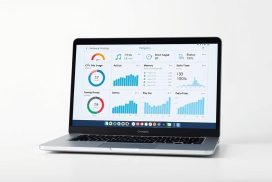How to Fix a Laptop Screen That’s Not Working: Step-by-Step Guide
Having a problematic laptop screen can be very annoying. Issues may include flickering, discoloration, or even a display that won’t respond. By learning how to tackle these problems, you could save both time and money.
This guide will show you how to identify laptop display issues, troubleshoot them effectively, and carry out repairs when needed. It also emphasizes the need to care for your device. Taking charge of small problems promptly can prevent expensive fixes. Repair costs often range from £100 to £600, depending on the model.
Identifying the Problem with Your Laptop Screen
Laptop screens can show many problems, like distortions or failing to show anything. Knowing what these signs mean helps figure out if the screen or something else is broken.
Common Symptoms of a Faulty Screen
Laptop screens can show several warning signs:
- A blank screen may mean big hardware problems.
- Flickering could be due to old drivers, bad connections, or backlight issues.
- Lines on the screen might indicate damage or issues with the graphics card.
- Dead pixels are annoying but sometimes can be fixed.
- A cracked screen usually needs a pro to check it.
Understanding Hardware vs. Software Issues
It’s crucial to know if a problem is caused by hardware or software. Hardware troubles often come from:
- Broken screens or connections.
- Worn-out backlights needing fixes or replacement.
- Poor power supply affecting the display’s brightness.
On the other hand, software issues might include:
- Out-of-date or corrupted display drivers.
- Wrong settings for screen resolution or refresh rate.
Using tools from the laptop’s maker can help check if the hardware is okay. It also helps to test with another monitor. This makes it easier to find out what to fix.
Initial Troubleshooting Steps
When dealing with display problems, the first steps are crucial. Start by restarting your laptop. This simple action can often fix temporary bugs. If issues persist after a reboot, you need to explore further.
Restart Your Laptop
Initiating a laptop restart is essential. It can solve short-term problems affecting your system. Doing this regularly helps prevent small issues from becoming big ones.
Check Power Supply and Connections
After rebooting, make sure to check your laptop’s power supply and connections. Lack of power can cause display issues. Look over cords and cables for secure connections and no damage. A black screen often means there’s a connection problem.
Test with an External Monitor
Using an external monitor can help find the problem. Connect a second screen to see if the issue is with your laptop’s display. If the external monitor works fine, the fault is likely with your laptop’s screen or connections. No display on the external screen points to a bigger issue.
Common Fixes Before Screen Replacement
Laptop screen problems might not always need a costly fix. Simple steps can often solve display issues or physical damage. This can make your laptop work better and last longer.
Updating Video Card Drivers
Old video card drivers often cause display problems. Checking device manager for updates can help. Update video card drivers to keep your screen working well. This makes your laptop’s screen look better and respond faster.
Cleaning Keyboard and Screen Areas
Dust and dirt can slow down your laptop. It helps to clean laptop keyboard and clean laptop screen regularly. Cleaning around hinges and latches is also important. Dirt here can make the screen act up.
Addressing Dead Pixels and Screen Burn-In
Software that changes colours quickly can fix dead pixels. This can make them work again. For screen burn-in, showing a white screensaver can help. It reduces ghost images over time.
How to Fix Laptop Screen Not Working: Step-by-Step Repair Process
To fix a laptop screen properly, you need the right tools. It’s important to have laptop screen repair tools ready. These include small Phillips screwdrivers and a spudger tool for prying components apart. Also, a matching new LCD screen is essential. Sometimes, you may also need double-sided tape for reattaching parts.
Tools You’ll Need for the Repair
- Small Phillips screwdriver
- Spudger tool
- Replacement LCD screen
- Double-sided tape (optional)
Step-by-Step Instructions
The laptop screen replacement process starts by ensuring the laptop is off and all power sources are disconnected. It’s key to follow a step-by-step repair guide for efficient fixing:
- Power off the laptop and unplug it.
- Remove the screen’s bezel cautiously.
- Take the old screen out and unplug the video cable.
- Fit the new screen by following the previous steps backwards.
- Put the bezel back on and tighten all screws.
Precautions to Take During the Repair
Being cautious is vital for a good repair. Here are some safety tips for laptop repairs:
- Make sure to be grounded to avoid static damage.
- Keep all screws and tiny parts organised when you take them out.
- Go slowly to not harm any fragile parts.
Looking at resources like this guide can offer extra tips and visual help for your repair, making the process smoother.
When to Replace Your Laptop Screen
Knowing when to replace your laptop screen keeps it working well. You must spot the signs of laptop screen damage, like cracks, weird colours, or display issues. When simple fixes don’t work, it’s probably time to replace laptop screen.
Signs of Physical Damage
Physical damage can make your laptop hard to use. Look out for things like:
- Cracks or chips on the screen surface
- Fluttering display or persistent black screens
- Flickering or distorted colours
- Dead pixels on the display
When these problems start, you need to see how bad the damage is. Small scratches might be okay, but serious damage means you need to fix it.
Finding the Right Replacement Screen
To find replacement laptop screen, it must fit your device’s needs. Consider these:
- Screen size and resolution
- Connection type (e.g., eDP, LVDS)
- If the screen works with your laptop
Look at the model number on your current screen’s back to find a compatible laptop screen model. This helps you look for the right screens from trusted places. For more help, check out this resource.
| Screen Type | Common Issues | Replacement Cost |
|---|---|---|
| Older LCD (CCFL) | Flickering, dim backlight | Approx. $80 |
| Newer LED (LCD) | Cracks, dead pixels | Up to $750 |
| MacBook | Colour distortion, no image | Up to $750 |
Conclusion
This guide gave you all you need to know about fixing a laptop screen. We’ve covered key troubleshooting steps, common solutions, and detailed repair methods. It’s key to quickly deal with any screen issues to stop bigger problems or expensive fixes later.
Keeping your laptop well-maintained can greatly improve its life and how well it works. Simple steps like checking the power, fitting components properly, and keeping connections clean can boost its performance. These actions can stop many issues before they start.
Taking action and staying informed helps users have a smoother time with their computers. Whether it’s small fixes or big repairs, knowing how to keep your laptop running well is crucial. This knowledge can save your device and keep it working as it should.
FAQ
What are the common symptoms of a faulty laptop screen?
Look out for issues like a screen that won’t show anything, images that flicker, lines across the screen, ghost-like images, and physical damage. Things like cracks or broken glass are easy to spot.
How can I differentiate between hardware and software issues?
Hardware problems may involve a broken screen or loose parts, while software issues often come from outdated drivers. To figure out the problem, check for visible damage and play around with the system settings.
What should I do if my laptop screen is blank?
Start by restarting your laptop to fix any software glitches. If it’s still blank, make sure your laptop has enough power and that all connections are secure.
How can I determine if the issue is with my laptop screen or the laptop itself?
Connect your laptop to another monitor. If the other monitor works fine, the issue is likely with your laptop’s screen or its connections. But if the other monitor doesn’t work either, your laptop might have a deeper issue.
What maintenance can I perform to prevent display issues?
Keep your laptop clean, especially around the keyboard and screen. Cleaning the hinges and latch areas helps stop dust and small bits from causing trouble.
What tools do I need for a laptop screen repair?
You’ll need small screwdrivers, a spudger to gently open parts, and the right LCD screen. Sometimes, double-sided tape is also useful for keeping things in place.
When should I consider replacing my laptop screen?
Think about a new screen if you see cracks, weird colours, or if the display keeps failing. Check the damage closely to decide if you can still fix it or if a replacement is needed.
How do I find the right replacement screen for my laptop?
Make sure the new screen matches your laptop’s model. This includes the size, resolution, and how it connects. You can usually find your model number on the back of the old screen, which helps in picking the right replacement.













